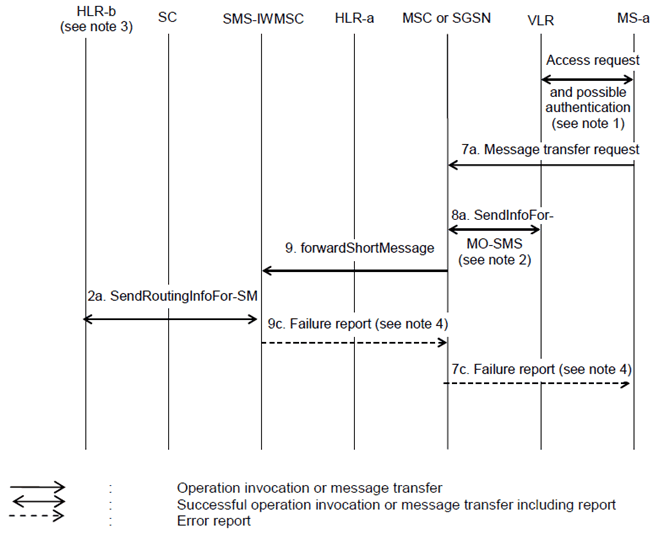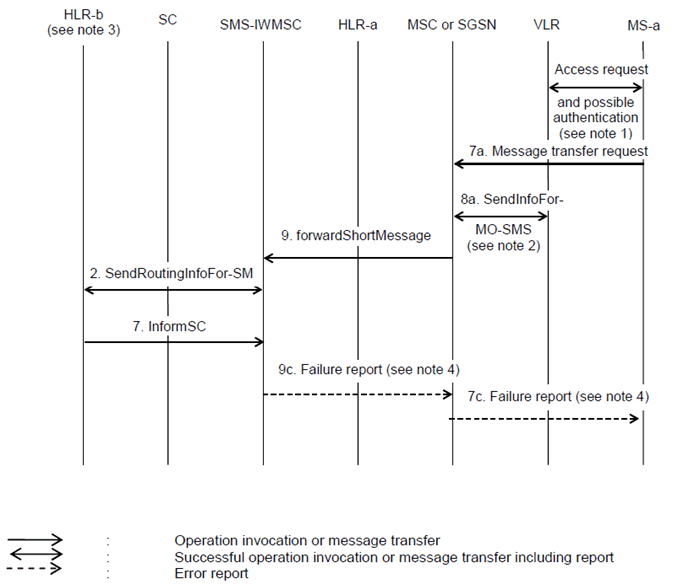Content for TS 23.040 Word version: 18.0.0
0…
3…
3.3…
4…
8…
9…
9.2…
9.2.2.2…
9.2.2.3…
9.2.3…
9.2.3.12…
9.2.3.24
9.2.3.24.1…
9.2.3.24.10…
9.2.3.24.10.1.12…
9.2.3.24.10.2…
9.2.3.24.11…
9.2.3.25…
9.3…
10…
10.1.1…
10.1.3…
10.1.5…
10.1.7…
10.1.9…
10.1.11…
10.1.13…
10.1.15…
10.1.17…
10.2
10.2.1…
10.2.3…
10.2.5…
10.2.7…
10.3
11…
A…
C
C.1…
C.3…
C.5…
C.7…
C.9…
C.11…
C.13…
C.15…
D…
E…
F…
G…
G.2…
G.6
G.7
H…
I…
J…
K…
10.2.7 — fig. 18g p. 137

Figure 18g: Short Message transfer attempt failing due to non-existence of an SMS Interworking agreement
(⇒ copy of original 3GPP image)
(⇒ copy of original 3GPP image)
After completing operation 2, SMS-IWMSC could check whether SMS interworking agreement exists or not based on IMSI. In this Figure 18g case, there is no SMS Interworking agreement between operators.
10.2.8 — fig. 18h p. 138

Figure 18h: Short Message transfer attempt failing due to negative outcome of HLR information retrieval
(⇒ copy of original 3GPP image)
(⇒ copy of original 3GPP image)
If SMS-IWMSC receives an informSC Message, then this message shall be ignored by the SMS-IWMSC.
If a failure report is indicated by the HLR after invocation of the "sendRoutingInfoForShortMsg" operation, the SMS-IWMSC shall return the appropriate error information to the MSC/SGSN with the error cause coded as follows:
| Return error from SendRoutingInfoForSM | Error mapping to ForwardShortMessage |
|---|---|
| system Failure | system Failure |
| data Missing | system Failure |
| Unexpected Data Value | system Failure |
| facility Not supported | SM Delivery Failure cause: invalid SME-address |
| unknown Subscriber | SM Delivery Failure cause: invalid SME-address |
| teleservice Not provisioned | SM Delivery Failure cause: invalid SME-address |
| Call barred | SM Delivery Failure cause: invalid SME-address |
| Absent Subscriber SM | SM Delivery Failure cause: invalid SME-address |
Operation 2:
sendRoutingInfoForShortMsg.
The operation is an interrogation of the HLR by the SMS-IWMSC to retrieve information necessary to forward the short message.
The outcome of the operation comprises either success, where the result contains the IMSI for terminated UE, or failure, which may be caused by several reasons.
Operation 7:
Message transfer MS → MSC or MS → SGSN.
The operation is used to transfer a short message from the MS to the MSC or to the SGSN.
Operation 8:
sendInfoForMO-SMS.
The operation provides a means for the MSC to verify from the VLR that the mobile originated short message transfer does not violate supplementary services invoked or restrictions imposed using the network feature Operator Determined Barring.
A successful VLR response carries the MSIsdn of the originating MS being transferred to the SC at SM-RL.
Operation 9:
forwardShortMessage.
The operation provides a means for the MSC or for the SGSN to transfer a short message to the SMS-IWMSC.
The procedure is required if the serving MSC or SGSN cannot access the SC directly, e.g. because it has no connection to SC (see clause 5).
The procedure works in tandem with the forwarding of the short message from the SMS-IWMSC to the SC. Thus, the outcome of the operation comprises either success, i.e. that the message has been delivered to the SC; or a failure that may be caused by several reasons, e.g. failure in the transfer MSC → SMS-IWMSC or SGSN → SMS-IWMSC, SC does not comply.
Operation 10:
Message transfer SMS-IWMSC → SC.
The operation is used to transfer a short message from an SMS-IWMSC to an SC, and consists of:
- the transfer of a message containing the TPDU from the SMS-IWMSC to the SC (see "10a. Message transfer" in Figure 18); and
- the return of either a "Failure report" (see 10c. in Figure 18) or a "Delivery report" (see 10b. in Figure 18).